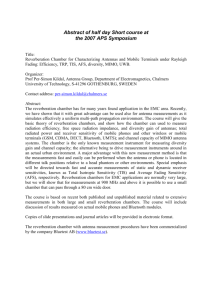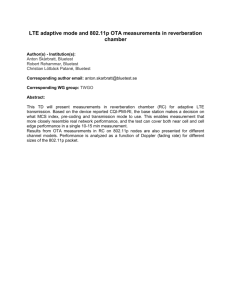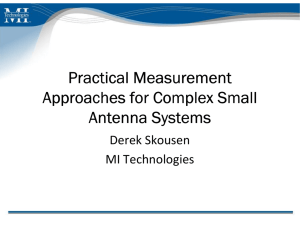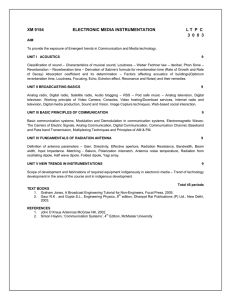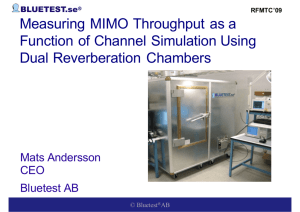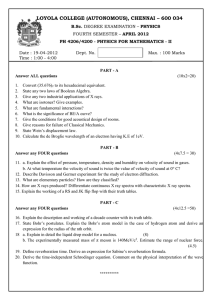Technical Visit of Measurement Facilities in Laboratoire de
advertisement
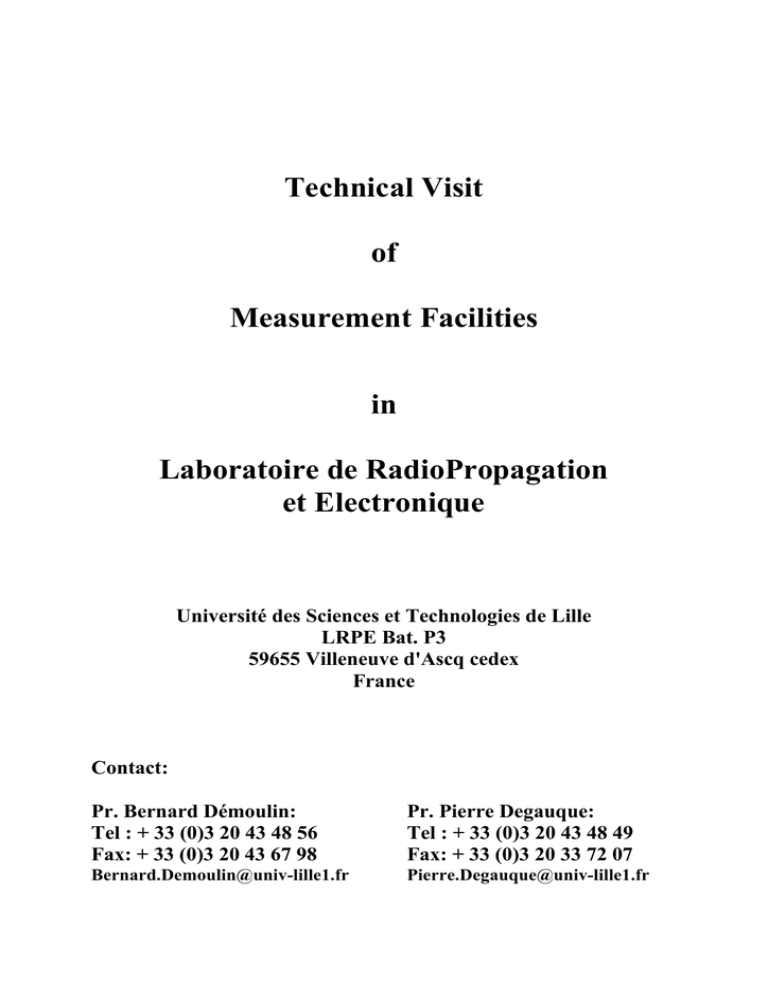
Technical Visit of Measurement Facilities in Laboratoire de RadioPropagation et Electronique Université des Sciences et Technologies de Lille LRPE Bat. P3 59655 Villeneuve d'Ascq cedex France Contact: Pr. Bernard Démoulin: Tel : + 33 (0)3 20 43 48 56 Fax: + 33 (0)3 20 43 67 98 Pr. Pierre Degauque: Tel : + 33 (0)3 20 43 48 49 Fax: + 33 (0)3 20 33 72 07 Bernard.Demoulin@univ-lille1.fr Pierre.Degauque@univ-lille1.fr Visit of the Laboratoire de RadioPropagation et Electronique LRPE In connection with the COST’meeting a visit of the measurement facilities of the LRPE will be organized. The visit is focused toward the activities of the laboratory in the domains of EMC. Short conferences about the works performed by the LRPE in the field of numerical simulations applied to solve EMC problems and examples of tests carried out in mode stirred reverberation chamber, anechoic chamber and TEM cell are presented. Program of the visit S. Baranowski Theoretical simulation of mode stirred reverberation chambers by means of optical approaches L. Koné, A. Lorthois Behavior of small rectangular shaped cavities tested in mode stirred reverberation chambers B. Démoulin, L. Koné Transfer impedance measurements of shielded cables and connectors R. Razafferson, P. Mariage Measurements of Emission due to Power Line Communication Systems J. Baudet, I. Abadi Characterization of the Emission of Integrated Circuits and PCBs The location of the visit will be at the ground of building P3 on the campus of Villeneuve d’Ascq. The name of the laboratory is changing, the new will be: TELICE (Laboratoire de Télécommunications, Interférences et Compatibilité Electromagnétique) Theoretical Simulation of Mode Stirred Reverberation Chambers by means of Optical Approaches S. Baranowski Université des Sciences et Technologies de Lille LRPE (TELICE) Sylvie.Baranowski@univ-lille1.fr Summary of the activities of LRPE (TELICE) in theoretical simulation of mode stirred reverberation chamber (MSRC) Theoretical simulation of the field distribution inside MSRC are today considered, in order to improve the mode stirred methods and to characterize the electromagnetic coupling phenomena introduced by the devices under test. At high frequencies range, we can consider that the dimensions of the reverberation chamber are large compared to the wavelength. In these conditions an optical approach may be used to predict the field distribution in the room. Then, the electromagnetic field at any point within the cavity may be considered as the sum of the incident wave merging from the source antenna and the multiple reflections occurring on the walls of the room. Paths and amplitude of the reflected waves are equivalent to the radiation of N shifted images of the antenna source weighted by the reflection parameters of the walls. Due to the high conductivity of the walls, the reflection parameters are closed to one, and then a too large number of images is required to reach a numerical convergence. In order to solve this problem, different solutions are studied: • statistical analysis of the field distribution According to many authors, the field distribution provided by a perfect mode stirred method is governed by the well known χ distribution; a similar distribution is also observed for a lot of receiving points randomly spaced in the room and for short variations of the carrier frequency of the source. Consequently, the number N of images, required by the computation, are determined when the cumulative distribution function of the field amplitude becomes stationary. The use of this criterion may reduce seriously the consuming time of the computation. Theses results are compared with others obtained with FDTD or finite element codes developed by EADS. • 2D approach A less consuming time 2D approach can be useful to evaluate the method (in this case, the cavity is modelized by a wave guide cross section, fed by a line of dipoles). The considered number of images can then be very high (compared to a 3D approach) and the convergence phenomenon can be studied. The results are compared with others obtained in Supelec, with a 2D finite elements approach (details can be found in the paper of M. Cauterman). Behavior of Small Rectangular shaped Cavities tested in Mode Stirred Reverberation Chamber L. Kone, A. Lorthois Université des Sciences et Technologies de Lille LRPE (TELICE) Lamine.Kone@univ-lille1.fr Summary of the activities of LRPE (TELICE) in reverberation chambers A reverberation chamber of sizes 2.5 m x 1.8 m x 2.8 m was installed in our laboratory seven years ago. After a first exploration of this measuring tool the studies were focused toward the characterization of the field distribution in the room and test on various devices such cable assemblies and more recently on containers of medium sizes. Experiment field consists to compare the measurements carried out in mode stirrer reverberation chamber with anechoic room under the condition of plane wave illumination. These works are achieved with the cooperation of aircraft industry especially with EMC group of the French research center of EADS company. To avoid heavy experiments in reverberating room of large sizes EADS is developing a specific numerical code devoted to the simulation of the MSRC field distribution. Experiment presented in the visit deals with the test on small shielded enclosures. Another study in this area concerns the statistical laws which may use to characterize the field distribution features in reverberation room. This work relevant to a cooperation with the Politecnico di Torino (Italy) and Techno Centre RENAULT (France) is based on statistical tests and measurements carried out in rooms of different sizes. Use of a transmission line model is considering in order to calibrate the specified field amplitude in the room. Third study on MSRC is working with the contribution of Supélec ( France). Aim is to develop a two dimensional models (wave guide cross section) in order to acquire amount of data about the distribution of the field versus a wave number scale. This approach will be connected with the concept of random plane waves distribution and to test the optical ray approaches. (contribution of S. Baranowski brings details on this last topic). Transfer Impedance Measurements of Shielded Cables and Connectors B. Démoulin, L. Koné Université des Sciences et Technologies de Lille LRPE (TELICE) Bernard.Demoulin@univ-lille1.fr Summary of the activities of LRPE (TELICE) in transfer impedance measurements Since 1973 the LRPE group acquired experience in the domain of transfer impedance measurements. Firstly were developed a triaxial bench test and use of transient current injection in order to determine the absolute value and phase angle of leaky feeders’ Zt with low optical coverage braided shield. Afterward, these studies were extended to the measurement of Zt at increase frequencies up to few GHz. Special bench test proposed by our group in eighty nine was developed In order to avoid phase delay due to the propagation phenomena. Therefore the measurements are carried out on a small gap (10 cm) of the cable shield. The outer disturbing current is generated by means of a short circuited coaxial cavity of 70 cm long. Below 100 MHz the measurement is like the usual triaxial method while above 100 MHz Zt is given at specific frequencies fitted with the resonance of the cavity. This method is also applied to test the transfer impedance of connectors. Illustration of this method is proposed in the visit. Other works about the characterization of the shielding effectiveness of cable assemblies are also turned toward the transfer impedance concept applied to the multi wires shielded cables. Theoretical simulations and measurements were aimed to point out the effect of the expected inner eigen modes. More recently these studies were extended to micro wave domain especially to compare various measurements tools as TEM cell, GTEM cell, Wire injection method*, INTEC cell**, LRPE cell*** and MSRC****. These studies were performed under a financial support of the European Project SOBITS managed by Universiteit Gent (Belgium). * Wire injection method is found in IEC standard IEC 96-1 ** INTEC cell is a small sizes bench test developed by the University of Gent and devoted to the measurements on small connectors *** LRPE cell is the bench test mentioned above **** MSRC is the Mode Stirrer Reverberation Chamber as found in IEC standard( IEC 1726 draft) Measurements of emission due to Power Line Communications Systems R.Razafferson, P.Mariage Université des Sciences et Technologies de Lille LRPE (TELICE) Richard.raza@univ-lille1.fr Summary of the activities of LRPE (TELICE) in anechoic chamber Actual trend of telecommunication systems is to use the power lines as electromagnetic guide in order to travel digital data on short distance as the indoor power network. Some scientific works are achieving in order to determine the maximum available power of high frequency signals injected on these lines and specify the immunity level of the concerned circuits. Early 2001 our laboratory started some studies about this subject under cooperation with France Telecom R&D. Aim was to perform experiments and simulation to understand the physical mechanisms involved trough the propagation, radiation and induction phenomena of transmission lines with random parameters. The experiment proposed in the visit deals with the measurements carried out on low voltage power line tested inside the anechoic chamber installed in our laboratory. Size of the room being 5.4 m x 5.17 m x 2.45 m a cable sample of four meters long may be tested without connection on the local power network. Aim of the measurements is to determine the magnetic field amplitude in the vicinity of the cable at distance from 20 cm up 1 meter. The concerned frequency range goes from 1 MHz to 30 MHz. The collected measurements correspond to the curves giving the variation of the magnetic field amplitude versus the frequency under various configurations of the indoor line model test cable with random arrangement of phase, neutral and ground wires. An Ideal transmission line like a bifilar with parallel wires is also tested in order to compare the results with the predictive models based on the uniform parameters transmission line theory. Future developments of these studies will concern other experiments performed inside a room equipped with a real power line network. Characterization of the Emission of Integrated Circuits and PCBs J. Baudet , I. Abadi Université des Sciences et Technologies de Lille LRPE (TELICE) Jacques.Baudet@univ-lille1.fr Summary of the activities of LRPE (TELICE) in electronic components and EMC Studies relevant to electronic components and EMC were started by our group in 1988 in order to determine the sensitivities of various usual ICs technologies. These works were performed under the cooperation with INRETS (French ministry of transportation) to insure safety of automatic vehicles controlled by aboard electronic equipment. These studies concerned the sensitivity estimation of digital circuits against disturbances sent toward the input, output and supply ports of the component. Another project was connected with the disturbances applied at operational amplifier ports. Sensitivity against destructive and non destructive disturbances was concerned respectively. Physical interpretation of the spurious phenomena as off set voltage or rectification due to non destructive incoming interference was achieved with the help of specified test board and theoretical simulation taking into account the contribution of expected inner parasitic parameters of the circuit. More recently activities in this domain was turned toward the emission of the digital circuits and immunity under combination of interference sources. Study of the emission was performed in cooperation with ALCATEL Bell in Antwerpen (Belgium). Aim was to link the radiation of the circuit with the characteristics of the inner working signals. TEM cell was an attractive tool to collect data about the radiation of the chip and its connected traces board. Experiment presented in the visit deals with this topic. Another work about EMC coupling and electronic component is leading under a France-Morocco cooperation with the Ecole Supérieure de Technologie de Fès (Morocco) on the effect of combination of disturbances occurring at the input of a digital circuit. Especially are concerned the addition of the effect due to electromagnetic cross talk coupling throughout the trace on board and induced voltages (or current) by an external radio frequency source working above 100 MHz. Under these conditions we show that external field controls the sensitivity toward the cross talk coupling.
